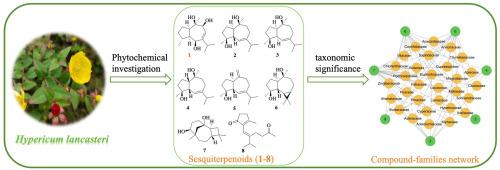兰开斯特金丝桃(金丝桃科)地上部的倍半萜类化合物及其化学分类意义
IF 2
4区 生物学
Q4 BIOCHEMISTRY & MOLECULAR BIOLOGY
引用次数: 0
摘要
对兰开斯特金丝桃(Hypericum lancasteri)地上部的植物化学研究分离并鉴定了8个倍半萜类化合物,包括1个未描述的瓜蓝烷类化合物(1)和7个已知的倍半萜类化合物(2-7)。通过1D / 2d nmr和HR-ESI-MS等波谱技术对新化合物的结构进行了鉴定。已知化合物是通过与文献报道的物理化学性质和光谱数据进行比较来鉴定的。值得注意的是,所有的倍半萜类化合物均为首次从该植物中分离得到,其中化合物1 ~ 6和8为首次从金丝桃科植物中分离得到。讨论了这些分离的倍半萜类化合物的分类意义,有助于对金丝桃科植物的化学分类有更广泛的认识。本文章由计算机程序翻译,如有差异,请以英文原文为准。

Sesquiterpenoids from the aerial parts of Hypericum lancasteri (Hypericaceae) and their chemotaxonomic significance
The phytochemical investigation on the aerial parts of Hypericum lancasteri led to the isolation and characterization of eight sesquiterpenoids, including an undescribed one belonging to guaiane-type (1) and seven known sesquiterpenoids (2–7). The structure of the new compound was elucidated by spectroscopic techniques, including 1D-/2D-NMR spectroscopy and HR-ESI-MS analysis. The known compounds were identified by comparison of their observed physicochemical properties and spectroscopic data with those reported in the literature. Notably, all isolated sesquiterpenoids were obtained from H. lancasteri for the first time, and compounds 1–6 and 8 are reported here for the first time in the family Hypericaceae. The taxonomic significance of these isolated sesquiterpenoids was discussed, contributing to a broader understanding of the chemotaxonomic classification within the family Hypericaceae.
求助全文
通过发布文献求助,成功后即可免费获取论文全文。
去求助
来源期刊

Biochemical Systematics and Ecology
生物-进化生物学
CiteScore
3.00
自引率
12.50%
发文量
147
审稿时长
43 days
期刊介绍:
Biochemical Systematics and Ecology is devoted to the publication of original papers and reviews, both submitted and invited, in two subject areas: I) the application of biochemistry to problems relating to systematic biology of organisms (biochemical systematics); II) the role of biochemistry in interactions between organisms or between an organism and its environment (biochemical ecology).
In the Biochemical Systematics subject area, comparative studies of the distribution of (secondary) metabolites within a wider taxon (e.g. genus or family) are welcome. Comparative studies, encompassing multiple accessions of each of the taxa within their distribution are particularly encouraged. Welcome are also studies combining classical chemosystematic studies (such as comparative HPLC-MS or GC-MS investigations) with (macro-) molecular phylogenetic studies. Studies that involve the comparative use of compounds to help differentiate among species such as adulterants or substitutes that illustrate the applied use of chemosystematics are welcome. In contrast, studies solely employing macromolecular phylogenetic techniques (gene sequences, RAPD studies etc.) will be considered out of scope. Discouraged are manuscripts that report known or new compounds from a single source taxon without addressing a systematic hypothesis. Also considered out of scope are studies using outdated and hard to reproduce macromolecular techniques such as RAPDs in combination with standard chemosystematic techniques such as GC-FID and GC-MS.
 求助内容:
求助内容: 应助结果提醒方式:
应助结果提醒方式:


